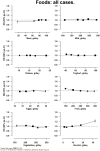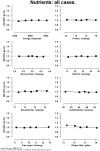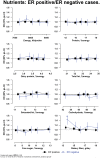Foods, macronutrients and breast cancer risk in postmenopausal women: a large UK cohort
- PMID: 30412247
- PMCID: PMC6469308
- DOI: 10.1093/ije/dyy238
Foods, macronutrients and breast cancer risk in postmenopausal women: a large UK cohort
Erratum in
-
Erratum: Foods, macronutrients and breast cancer risk in postmenopausal women: a large UK cohort.Int J Epidemiol. 2019 Apr 1;48(2):660. doi: 10.1093/ije/dyy281. Int J Epidemiol. 2019. PMID: 30517643 Free PMC article. No abstract available.
Abstract
Background: The role of diet in breast cancer aetiology is unclear; recent studies have suggested associations may differ by estrogen receptor status.
Methods: Baseline diet was assessed in 2000-04 using a validated questionnaire in 691 571 postmenopausal UK women without previous cancer, who had not changed their diet recently. They were followed by record linkage to national cancer and death databases. Cox regression yielded adjusted relative risks for breast cancer for 10 food items and eight macronutrients, subdivided mostly into five categories of baseline intake. Trends in risk across the baseline categories were calculated, assigning re-measured intakes to allow for measurement error and changes in intake over time; P-values allowed for multiple testing.
Results: Women aged 59.9 (standard deviation (SD 4.9)) years at baseline were followed for 12 (SD 3) years; 29 005 were diagnosed with invasive breast cancer. Alcohol intake had the strongest association with breast cancer incidence: relative risk (RR) 1.08 [99% confidence interval (CI) 1.05-1.11] per 10 g/day higher intake, P = 5.8 × 10-14. There were inverse associations with fruit: RR 0.94 (99% CI 0.92-0.97) per 100 g/day higher intake, P = 1.1 × 10-6, and dietary fibre: RR 0.91 (99% CI 0.87-0.96) per 5 g/day increase, P = 1.1 × 10-4. Fruit and fibre intakes were correlated (ρ = 0.62) and were greater among women who were not overweight, so residual confounding cannot be excluded. There was no heterogeneity for any association by estrogen receptor status.
Conclusions: By far the strongest association was between alcohol intake and an increased risk of breast cancer. Of the other 17 intakes examined, higher intakes of fruit and fibre were associated with lower risks of breast cancer, but it is unclear whether or not these associations are causal.
Keywords: Foods; alcohol; breast cancer risk; estrogen receptor status; macronutrients.
© The Author(s) 2018. Published by Oxford University Press on behalf of the International Epidemiological Association.
Figures




References
-
- Armstrong B, Doll R. Environmental factors and cancer incidence and mortality in different countries, with special reference to dietary practices. Int J Cancer 1975;15:617–31. - PubMed
-
- Torre LA, Islami F, Siegel RL, Ward EM, Jemal A. Global cancer in women: burden and trends. Cancer Epidemiol Biomarkers Prev 2017;26:444–57. - PubMed
-
- Collaborative Group on Hormonal Factors in Breast Cancer. Breast cancer and breastfeeding: collaborative reanalysis of individual data from 47 epidemiological studies in 30 countries, including 50302 women with reast cancer and 96973 women without the disease. Lancet 2002;360:187–95. - PubMed
-
- Key TJ, Allen NE, Spencer EA, Travis RC. Nutrition and breast cancer. Breast 2003;12:412–16. - PubMed
-
- Secretan B, Straif K, Baan R et al. . A review of human carcinogens—Part E: tobacco, areca nut, alcohol, coal smoke, and salted fish. Lancet Oncol 2009;10:1033–34. - PubMed
Publication types
MeSH terms
Substances
Grants and funding
LinkOut - more resources
Full Text Sources
Medical

